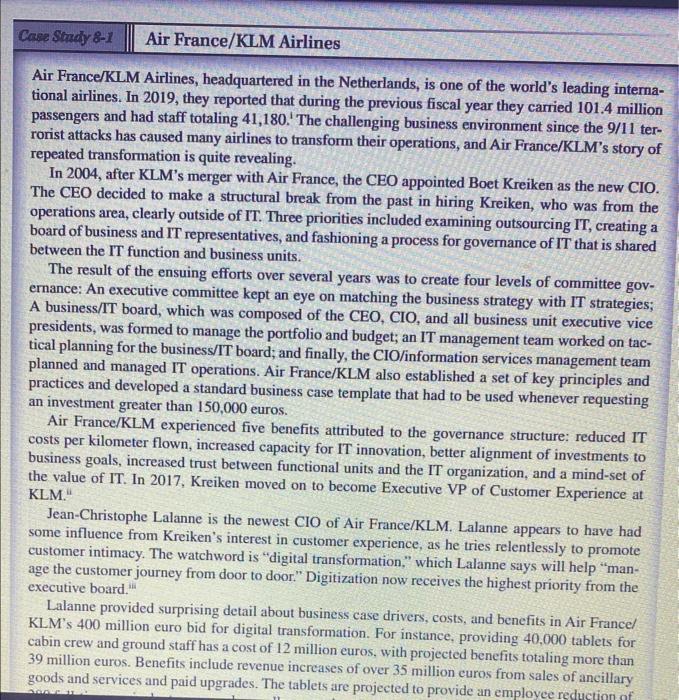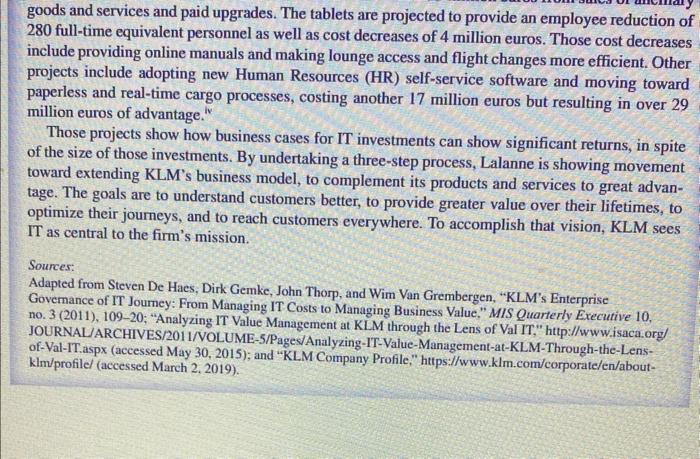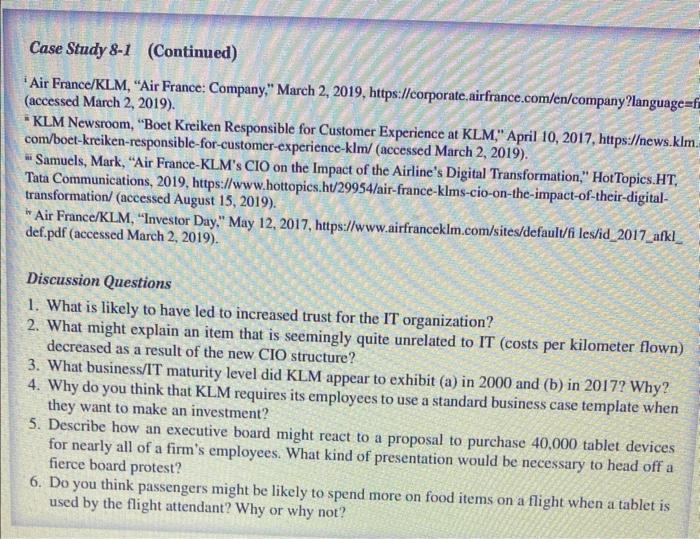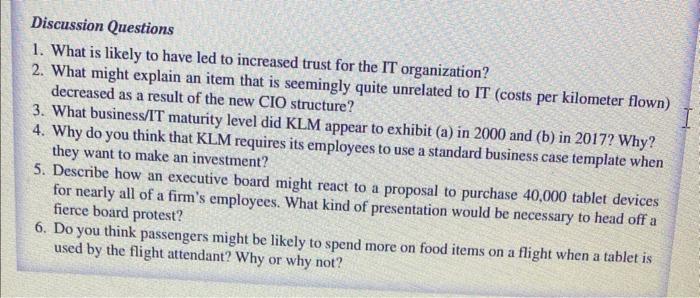1. what is likely to have led to increased trust for the it organization
2. what might explain an item that is seemly quite unrelated to IT (costs per kilometer flown) decreased as a result of the new CIO structure?
3. what business / It maturity level did KLM appear to exhibit A. in 2000 B. in 2017? why?
4. why do you think that KLM rewuires its employes to use a standard business case template when they want to make a new investment?
5. Describe how an executive board might react to a proposal to purchase 40,000 tablet devices for nearly all of the firms employees. What kind of presentation would be necessary to head off a fierce board protest?
6. Do you think passengers might be likely to spend more on food items on a flight when a tablet is used by the flight attendant? why or why not?
(please answer all the questions. Does not go against chegg policy because they all relate to eachother)
Air France/KLM Airlines, headquartered in the Netherlands, is one of the world's leading international airlines. In 2019, they reported that during the previous fiscal year they carried 101.4 million passengers and had staff totaling 41,180 . 'The challenging business environment since the 9/11 terrorist attacks has caused many airlines to transform their operations, and Air France/KLM's story of repeated transformation is quite revealing. In 2004, after KLM's merger with Air France, the CEO appointed Boet Kreiken as the new CIO. The CEO decided to make a structural break from the past in hiring Kreiken, who was from the operations area, clearly outside of IT. Three priorities included examining outsourcing IT, creating a board of business and IT representatives, and fashioning a process for governance of IT that is shared between the IT function and business units. The result of the ensuing efforts over several years was to create four levels of committee governance: An executive committee kept an eye on matching the business strategy with IT strategies; A business/IT board, which was composed of the CEO, CIO, and all business unit executive vice presidents, was formed to manage the portfolio and budget; an IT management team worked on tactical planning for the business/IT board; and finally, the CIO/information services management team planned and managed IT operations. Air France/KLM also established a set of key principles and practices and developed a standard business case template that had to be used whenever requesting an investment greater than 150,000 euros. Air France/KLM experienced five benefits attributed to the governance structure: reduced IT costs per kilometer flown, increased capacity for IT innovation, better alignment of investments to business goals, increased trust between functional units and the IT organization, and a mind-set of the value of IT. In 2017, Kreiken moved on to become Executive VP of Customer Experience at KLM." Jean-Christophe Lalanne is the newest CIO of Air France/KLM. Lalanne appears to have had some influence from Kreiken's interest in customer experience, as he tries relentlessly to promote customer intimacy. The watchword is "digital transformation," which Lalanne says will help "manage the customer journey from door to door." Digitization now receives the highest priority from the executive board. Lalanne provided surprising detail about business case drivers, costs, and benefits in Air Francel KLM's 400 million euro bid for digital transformation. For instance, providing 40,000 tablets for cabin crew and ground staff has a cost of 12 million euros, with projected benefits totaling more than 39 million euros. Benefits include revenue increases of over 35 million curos from sales of ancillary goods and services and paid upgrades. The tablets are projected to provide an emplovee reduction of goods and services and paid upgrades. The tablets are projected to provide an employee reduction of 280 full-time equivalent personnel as well as cost decreases of 4 million euros. Those cost decreases include providing online manuals and making lounge access and flight changes more efficient. Other projects include adopting new Human Resources (HR) self-service software and moving toward paperless and real-time cargo processes, costing another 17 million euros but resulting in over 29 million euros of advantage. iN Those projects show how business cases for IT investments can show significant returns, in spite of the size of those investments. By undertaking a three-step process, Lalanne is showing movement toward extending KLM's business model, to complement its products and services to great advantage. The goals are to understand customers better, to provide greater value over their lifetimes, to optimize their journeys, and to reach customers everywhere. To accomplish that vision, KLM sees IT as central to the firm's mission. Sources: Adapted from Steven De Haes, Dirk Gemke, John Thorp, and Wim Van Grembergen, "KLM's Enterprise Governance of IT Journey: From Managing IT Costs to Managing Business Value," MIS Quarterly Executive 10, no. 3 (2011), 109-20; "Analyzing IT Value Management at KLM through the Lens of Val IT," http:/lwww.isaca.org/ JOURNALARCHIVES/2011/VOLUME-5/Pages/Analyzing-IT-Value-Management-at-KLM-Through-the-Lensof-Val-TTaspx (accessed May 30, 2015); and "KLM Company Profile," https://www.klm.com/corporate/en/aboutklm/ profile/ (accessed March 2, 2019). 'Air France/KLM, "Air France: Company," March 2, 2019, https:I/corporate.airfrance.com/en/company?language= (accessed March 2, 2019). "KLM Newsroom, "Boet Kreiken Responsible for Customer Experience at KLM," April 10, 2017, https:/ews.klm com/boet-kreiken-responsible-for-customer-experience-klm/ (accessed March 2, 2019). wi Samuels, Mark, "Air France-KLM's CIO on the Impact of the Airline's Digital Transformation," HotTopics.HT, Tata Communications, 2019, https://www.hottopics. ht/29954/air-france-klms-cio-on-the-impact-of-their-digitaltransformation/ (accessed August 15, 2019). "Air France/KLM, "Investor Day," May 12, 2017, https://www.airfranceklm.com/sites/defaul//fi les/id_2017_afkl def.pdf (accessed March 2, 2019). Discussion Questions 1. What is likely to have led to increased trust for the IT organization? 2. What might explain an item that is seemingly quite unrelated to IT (costs per kilometer flown) decreased as a result of the new CIO structure? 3. What business/IT maturity level did KLM appear to exhibit (a) in 2000 and (b) in 2017 ? Why? 4. Why do you think that KLM requires its employees to use a standard business case template when they want to make an investment? 5. Describe how an executive board might react to a proposal to purchase 40.000 tablet devices for nearly all of a firm's employees. What kind of presentation would be necessary to head off a fierce board protest? 6. Do you think passengers might be likely to spend more on food items on a flight when a tablet is used by the flight attendant? Why or why not? Discussion Questions 1. What is likely to have led to increased trust for the IT organization? 2. What might explain an item that is seemingly quite unrelated to IT (costs per kilometer flown) decreased as a result of the new CIO structure? 3. What business/IT maturity level did KLM appear to exhibit (a) in 2000 and (b) in 2017 ? Why? 4. Why do you think that KLM requires its employees to use a standard business case template when they want to make an investment? 5. Describe how an executive board might react to a proposal to purchase 40,000 tablet devices for nearly all of a firm's employees. What kind of presentation would be necessary to head off a fierce board protest? 6. Do you think passengers might be likely to spend more on food items on a flight when a tablet is used by the flight attendant? Why or why not










